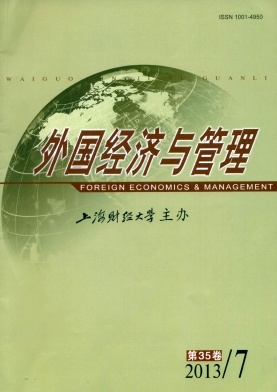母子公司治理研究脉络梳理与演进趋势探析
外国经济与管理 2013 年 第 35 卷第 07 期, 页码:35 - 42
摘要
参考文献
摘要
本文在文献梳理的基础上,先从积极治理效应内生和外生以及消极治理效应内生和外生四个视角对现有的母子公司单向治理研究进行了述评;然后,在剖析了单项治理研究不足之后,通过引入行为经济学的参照点契约理论,即放松子公司作为行为主体不能讨价还价的假设,对母子公司双向治理研究的现状进行了述评,最后对后续双向治理研究进行了简要展望。
[1]Aggarwal R and Dow S.Dividends and strength of Japanese business group affiliation[J].Journal of Economics and Busi-ness,2012,64(11/12):214-230.
[2]Andres P and Vallelado E.Corporate governance in banking:The role of the board of directors[J].Journal of Banking and Finance,2008,32(12):2570-2580.
[3]Azofra V and Santamaria M.Ownership,control,and pyra-mids in Spanish commercial banks[J].Journal of Banking&Finance,2011,35(6):1464-1476.
[4]Belkhir M.Board structure,ownership structure and firm performance:Evidence from banking[J].Applied Financial Economics,2009,19(2):1581-1593.
[5]Bennedsen M and Nielsen K.Incentive and entrenchment effects in European ownership[J].Journal of Banking&Fi-nance,2010,34(9):2212-2229.
[6]Cheong K,et al.Understanding the behavior of business groups:A dynamic model and empirical analysis[J].Journal of Economic Behavior&Organization,2010,76(2):141-152.
[7]Claessens S,et al.The separation of ownership and control in East Asian corporations[J].Journal of Financial Economics,2000,58(1/2):81-112.
[8]Dahya J,et al.Dominant shareholders,corporate boards,and corporate value:A cross-country analysis[J].Journal of Financial Economics,2008,87(1):73-100.
[9]Djankov S,et al.The law and economics of self-dealing[J].Journal of Financial Economics,2008,88(3):430-465.
[10]Dow S and McGuire J.Propping and tunneling:Empirical evidence from Japanese Keiretsu[J].Journal of Banking&Finance,2009,33(10):1817-1828.
[11]Gammelgaard J,et al.The impact of increases in subsidiary autonomy and network relationships on performance[J].In-ternational Business Review,2012,21(6):1158-1172.
[12]George R and Kabir R.Business groups and profit redistri-bution:A boor or bane for firms?[J].Journal of Business Research Research,2008,61(9):1004-1014.
[13]Hart O.Hold-up,asset ownership and reference points[J].Quarterly Journal of Economics,2009,124(1):267-300.
[14]Hughes J.Corporate value,ultimate control and law protec-tion for investors in Western Europe[J].Management Ac-counting Research,2009,20(1):41-52.
[15]Johnson S,et al.Tunneling[J].American Economic Re-view,2000,90(2):22-27.
[16]Khanna T.Business groups and social welfare in emerging markets:Existing evidence and unanswered questions[J].European Economic Review,2000,44(4/6):748-761.
[17]La Porta,et al.Corporate ownership around the world[J].Journal of Finance,1999,54(2):471-517.
[18]Lei A and Song F.Connected transactions and firm value:Evidence from China-affiliated companies[J].Pacific-Basin Finance Journal,2011,19(5):470-490.
[19]Li G.The pervasiveness and severity of tunneling by con-trolling shareholders in China[J].China Economic Review,2010,21(2):310-323.
[20]Lin C,et al.Corporate ownership structure and bank loan syndicate structure[J].Journal of Financial Economics,2012,104(1):1-22.
[21]Lin S and Hsieh A.International strategy implementation:Roles of subsidiaries,operational capabilities,and procedural justice[J].Journal of Business Research,2010,63(1):52-59.
[22]Lo A,et al.Can corporate governance deter management from manipulating earnings?Evidence from related-party sales transactions in China[J].Journal of Corporate Finance,2010,16(2):225-235.
[23]Lo A and Wong R.An empirical study of voluntary transfer pricing disclosures in China[J].Journal of Accounting and Public Policy,2011,30(6):607-628.
[24]Paligorova T and Xu Z.Complex ownership and capital structure[J].Journal of Corporate Finance,2012,18(4):701-716.
[25]Peng W,et al.Tunneling or propping:Evidence from con-nected transactions in China[J].Journal of Corporate Fi-nance,2011,17(2):306-325.
[26]Piana B,et al.Towards a better understanding of family business groups and their key dimensions[J].Journal of Fam-ily Business Strategy,2012,3(3):174-192.
[27]Santangelo G.The tension of information sharing:Effects on subsidiary embeddedness[J].International Business Re-view,2012,21(2):180-195.
[28]Tang J and Rowe W.The liability of closeness:Business re-latedness and foreign subsidiary performance[J].Journal of World Business,2012,47(2):288-296.
[29]Wang K and Xiao X.Controlling shareholders’tunneling and executive compensation:Evidence from China[J].Jour-nal of Accounting and Public Policy,2011,30(1):89-100.
[30]Yeh Y,et al.Related-party transactions and corporate go-vernance:The evidence from the Taiwan stock market[J].Pacific-Basin Finance Journal,2012,20(5):755-776.
[31]冯根福,赵珏航.管理者薪酬、在职消费与公司绩效——基于合作博弈的分析视角[J].中国工业经济,2012,(6):147-158.
[32]郝云宏.公司治理内在逻辑关系冲突:董事会行为视角[J].中国工业经济,2012,(9):96-121.
[33]徐细雄.参照点契约理论:不完全契约理论的行为与实验拓展[J].外国经济与管理,2012,(11):52-60.
[2]Andres P and Vallelado E.Corporate governance in banking:The role of the board of directors[J].Journal of Banking and Finance,2008,32(12):2570-2580.
[3]Azofra V and Santamaria M.Ownership,control,and pyra-mids in Spanish commercial banks[J].Journal of Banking&Finance,2011,35(6):1464-1476.
[4]Belkhir M.Board structure,ownership structure and firm performance:Evidence from banking[J].Applied Financial Economics,2009,19(2):1581-1593.
[5]Bennedsen M and Nielsen K.Incentive and entrenchment effects in European ownership[J].Journal of Banking&Fi-nance,2010,34(9):2212-2229.
[6]Cheong K,et al.Understanding the behavior of business groups:A dynamic model and empirical analysis[J].Journal of Economic Behavior&Organization,2010,76(2):141-152.
[7]Claessens S,et al.The separation of ownership and control in East Asian corporations[J].Journal of Financial Economics,2000,58(1/2):81-112.
[8]Dahya J,et al.Dominant shareholders,corporate boards,and corporate value:A cross-country analysis[J].Journal of Financial Economics,2008,87(1):73-100.
[9]Djankov S,et al.The law and economics of self-dealing[J].Journal of Financial Economics,2008,88(3):430-465.
[10]Dow S and McGuire J.Propping and tunneling:Empirical evidence from Japanese Keiretsu[J].Journal of Banking&Finance,2009,33(10):1817-1828.
[11]Gammelgaard J,et al.The impact of increases in subsidiary autonomy and network relationships on performance[J].In-ternational Business Review,2012,21(6):1158-1172.
[12]George R and Kabir R.Business groups and profit redistri-bution:A boor or bane for firms?[J].Journal of Business Research Research,2008,61(9):1004-1014.
[13]Hart O.Hold-up,asset ownership and reference points[J].Quarterly Journal of Economics,2009,124(1):267-300.
[14]Hughes J.Corporate value,ultimate control and law protec-tion for investors in Western Europe[J].Management Ac-counting Research,2009,20(1):41-52.
[15]Johnson S,et al.Tunneling[J].American Economic Re-view,2000,90(2):22-27.
[16]Khanna T.Business groups and social welfare in emerging markets:Existing evidence and unanswered questions[J].European Economic Review,2000,44(4/6):748-761.
[17]La Porta,et al.Corporate ownership around the world[J].Journal of Finance,1999,54(2):471-517.
[18]Lei A and Song F.Connected transactions and firm value:Evidence from China-affiliated companies[J].Pacific-Basin Finance Journal,2011,19(5):470-490.
[19]Li G.The pervasiveness and severity of tunneling by con-trolling shareholders in China[J].China Economic Review,2010,21(2):310-323.
[20]Lin C,et al.Corporate ownership structure and bank loan syndicate structure[J].Journal of Financial Economics,2012,104(1):1-22.
[21]Lin S and Hsieh A.International strategy implementation:Roles of subsidiaries,operational capabilities,and procedural justice[J].Journal of Business Research,2010,63(1):52-59.
[22]Lo A,et al.Can corporate governance deter management from manipulating earnings?Evidence from related-party sales transactions in China[J].Journal of Corporate Finance,2010,16(2):225-235.
[23]Lo A and Wong R.An empirical study of voluntary transfer pricing disclosures in China[J].Journal of Accounting and Public Policy,2011,30(6):607-628.
[24]Paligorova T and Xu Z.Complex ownership and capital structure[J].Journal of Corporate Finance,2012,18(4):701-716.
[25]Peng W,et al.Tunneling or propping:Evidence from con-nected transactions in China[J].Journal of Corporate Fi-nance,2011,17(2):306-325.
[26]Piana B,et al.Towards a better understanding of family business groups and their key dimensions[J].Journal of Fam-ily Business Strategy,2012,3(3):174-192.
[27]Santangelo G.The tension of information sharing:Effects on subsidiary embeddedness[J].International Business Re-view,2012,21(2):180-195.
[28]Tang J and Rowe W.The liability of closeness:Business re-latedness and foreign subsidiary performance[J].Journal of World Business,2012,47(2):288-296.
[29]Wang K and Xiao X.Controlling shareholders’tunneling and executive compensation:Evidence from China[J].Jour-nal of Accounting and Public Policy,2011,30(1):89-100.
[30]Yeh Y,et al.Related-party transactions and corporate go-vernance:The evidence from the Taiwan stock market[J].Pacific-Basin Finance Journal,2012,20(5):755-776.
[31]冯根福,赵珏航.管理者薪酬、在职消费与公司绩效——基于合作博弈的分析视角[J].中国工业经济,2012,(6):147-158.
[32]郝云宏.公司治理内在逻辑关系冲突:董事会行为视角[J].中国工业经济,2012,(9):96-121.
[33]徐细雄.参照点契约理论:不完全契约理论的行为与实验拓展[J].外国经济与管理,2012,(11):52-60.
引用本文
方政, 徐向艺. 母子公司治理研究脉络梳理与演进趋势探析[J]. 外国经济与管理, 2013, 35(7): 35–42.
导出参考文献,格式为:





 5548
5548  567
567

